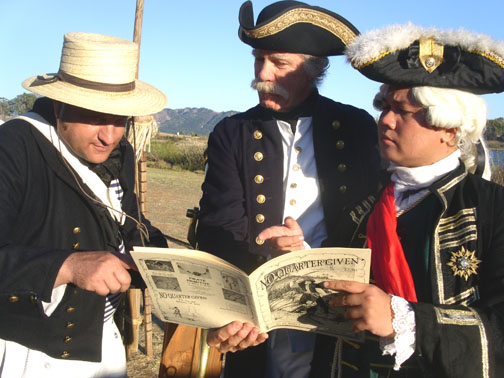


Stevenson Projects boats playing Broadside! Two Weekenders on the left, a nice red Skipjack, and a Mini-Cup on the right.
![]()
![]()
(the sailing race with an element of Skullduggery)
Before the race, each crew's boat is pulled up on the beach with sails furled (or tied up at the home dock). At the starting gun (we have used a carbide cannon on a wooden naval mount), the crews run to their boats and set sail for the first mark.
The following boats' crews can make a decision at this point. If they're close behind the lead boat, they can go on to the first landmark and get their own answer to the question on the chart, then try to beat the lead boat to the next mark. Or, (if they're trailing by quite a distance) they can attack the lead boat as it comes back toward the next mark, capture its float and, once they have the lead boat's float, they can demand that the lead boat's skipper tell them the answer to the first question. Then both boats can race to the next mark
Two closely matched boats may chose to make it a straight race, with boat boats winning their own answers at each landmark. But, in a race where a gap develops between boats, the trailing boat(s) can then attack the leading boat heading back to the next mark and try to capture its float so the race can start even for the next mark.
A really slow boat may have to position itself for capture after every mark and hope they can somehow finesse the lead boat into a capture at the end, and make it back to the beach first.
First boat crew to beach and bring its chart back (with all answers filled in) and stuff it into the barrel of the starting gun wins the beer, the wenches, the first chance at the salamagundi, or whatever booty has been set as prize.
![]()
Click Here to get in touch with them!
![]()

Copyright 2020 Stevenson Projects LLC

